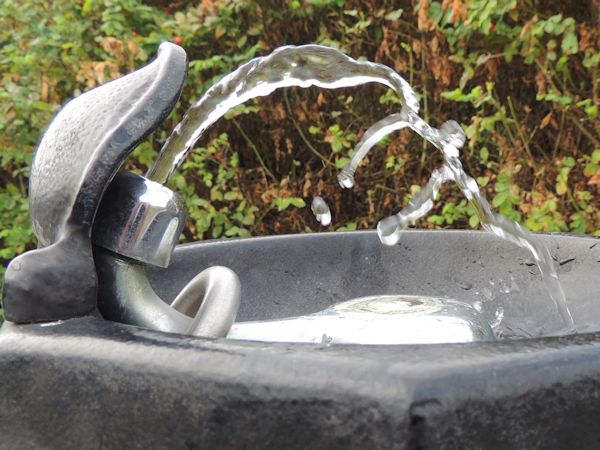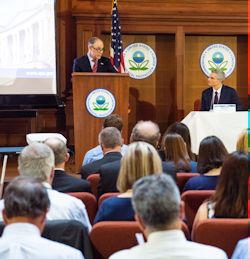SEJournal Online is the digital news magazine of the Society of Environmental Journalists. Learn more about SEJournal Online, including submission, subscription and advertising information.
 |
 |
| Drinking fountain in Edmonds, Wash. The state is one of numerous locations where PFASs have caused concern in recent years, prompting legislators there to ban the chemicals in food packaging made from paper and paperboard, beginning in 2022. Photo: Upupa4me, Flickr Creative Commons. Click to enlarge. |
TipSheet: In 2019, PFAS Chemicals Will Show Up in Drinking Water … and Headlines
EDITOR'S NOTE: This story is one in a series of special reports from SEJournal’s Joseph A. Davis that looks ahead to key issues in the coming year. Visit the full “2019 Journalists’ Guide to Energy & Environment” special report for more.
Communities across the country have been alarmed to find chemicals from the per- and polyfluoroalkyl family in their drinking water.
Nicknamed PFAS, they are a class of more than 3,000 chemicals in wide use for firefighting foams, food packaging, stain- and water-repellent fabrics, nonstick cookware and many other consumer products and industrial processes.
And per the U.S. Environmental Protection Agency: “There is evidence that exposure to PFAS can lead to adverse human health effects.”
So these communities are trying to do something about it. But what will the EPA do? What will your state do? Who will sue whom? Who will settle? Are there other chemicals in our drinking water that we should worry about?
Given all that, you can be sure that PFAS contamination of water will keep making news in 2019.
Contamination reports go back more than a decade
PFAS have some characteristics that make them a particular problem: Many are soluble in water, have surfactant properties, are persistent in organisms and the environment, and are bioaccumulative.
They work their way up the food chain and stay in your body for a long time. Some have been linked to cancer, among other health problems. Almost everyone has at least a tiny amount of PFAS in their blood.
PFAS started showing up in people’s water — and in the news — at least a dozen years ago, but incidents have accelerated in the last four years. They have caused concern from Vermont to Washington state to Michigan.
More cases of water contamination are being discovered every week. When PFAS show up, lawsuits and political crises often follow. So every time another community finds contamination, it will be news.
One environmental group estimated that up to 110 million Americans could be drinking water contaminated by PFAS. The Environmental Working Group has mapped out the contamination known to date.
Pressure to regulate under drinking water rules
There is already huge pressure on the U.S. Environmental Protection Agency to solve the problem, or at least … do something. That’s why it will be news.
Under the Safe Drinking Water Act, or SDWA, it is EPA’s job (and the states’) to make sure people have safe water to drink. Individual private wells do not fall under SDWA, and these are regulated by states and counties when they are regulated at all. They get contaminated, too.
Thing is: EPA doesn’t really have a rule yet to keep PFAS out of public drinking water systems.
The big thing to watch for is any sign of EPA
proposing (or preparing to propose)
a maximum contaminant level
for one or more of the PFAS chemicals.
Bring your knitting — it may be a wait.
Since Congress passed it back in 1974, SDWA has set up a delicate and complex regulatory system balancing the power of federal government, states and local water utilities. Each guards its power jealously. When something bad happens, each can blame the others. And often they do.
EPA’s role in this system is to set numerical limits on drinking water contaminants of concern. The legally enforceable ones are called “maximum contaminant levels,” or MCLs. There is currently no MCL for PFAS in effect, or even proposed.
EPA sets MCLs based on the health risks presented by a contaminant — not just its harmfulness, but its likelihood of occurrence — as well as practical considerations such as available treatment technology and cost. Once EPA sets an MCL, it is usually the job of state regulators to enforce it on the local utilities.
Setting MCLs is a complex regulatory process that takes years. So the big thing to watch for in 2019 is any sign of EPA proposing (or preparing to propose) an MCL for one or more of the PFAS chemicals. Bring your knitting — it may be a wait.
EPA ‘summit’ kept public, media at bay
 |
| Former EPA Administrator Scott Pruitt (at podium) speaking about the agency’s actions on PFAS at a controversial May 2018 “summit,” where access by general public and news media was limited. Photo: EPA. Click to enlarge. |
EPA does seem to know what it is up against. That’s why they have been acting squirrelly. In May 2018, while Scott Pruitt was still administrator, it held a publicized “summit.”
That’s different than a public meeting — federal and state and industry people were there, and a few reporters were allowed to perform stenography during Pruitt’s initial remarks, but the general public and news media were not allowed to witness most of the meeting, much less take part. In fact, an EPA guard roughed up an AP reporter who tried to cover the meeting. (And, yes, SEJ objected.)
EPA did hold some open listening sessions later in the summer. But if any agreement emerged from the meetings, we were not made aware of it. The meetings did demonstrate, however, that states and the public care intensely about PFAS.
SDWA does set out procedures for EPA to use in deciding which contaminants to regulate, and EPA has launched formal processes for deciding on whether to regulate six major kinds of PFAS. In 2016, during the Obama administration, for instance, EPA had issued health advisories for some PFAS, but these were nonbinding.
To date, though, EPA has not shown much tangible evidence of nearing a real MCL rulemaking on PFAS. It may be because doing scientifically sound regulatory work on PFAS is going to be exceptionally hard. Research on human health effects is often preliminary.
Also, there are so many (3,000-plus) in use that just one rule may not be appropriate. Many different sampling, testing and treatment methods may be needed. And most are likely to be more expensive than standard methods — and therefore hard for the many small drinking water systems to implement. Heartburn.
So one of the big questions examined at the May 2018 PFAS “Summit” was simply how many PFAS chemicals EPA should regulate. (One possible preliminary answer: start with the six major chemical subcategories EPA has already mapped out to work on.)
Administration lacks credibility on protection
People really want the federal government to tell them what levels of PFAS exposure are safe or harmful. One problem is that the Trump administration has little credibility when it comes to environmental health protection.
For example, there was widespread consternation in May 2018 when media discovered a report on PFAS toxicology by the Agency for Toxic Substances and Disease Registry that suggested safe levels far below those EPA was using. The report was being suppressed by the White House and EPA as a PR “nightmare.” Eventually it was published.
It is also hard to see EPA as a tough cop regulating industry when it continues to approve commercial use of new PFAS chemicals with its authority under the Toxic Substances Control Act — without solving problems from the ones it has already approved.
More recently EPA published its own draft study finding that chronic exposure to even small amounts of PFAS is dangerous — and that some of the newer compounds like GenX, used to replace older ones, are also very toxic.
EPA has also developed improved testing methods which can identify contamination by a wider array of PFAS at very low levels. And former EPA Administrator Pruitt once hinted that the agency might classify PFAS as hazardous under other EPA authorities that drive prevention and cleanup.
Legislation has even been introduced in Congress that would direct the U.S. Geological Survey to test widely for PFAS contamination of soil and water. Congress would fix the problem, but they don’t really know how. It wants EPA to fix it ... and fast.
Some states taking preemptive action
Meanwhile, some states and localities are not willing to wait. They have gone ahead on their own, winging it when they have to. At least eight states have taken some action and 11 others have been considering it.
A number of states are taking the approach of setting their own MCLs for enforcement of PFAS limits in drinking water. This is unusual, and perhaps a sign that the federal part of SDWA is failing.
Often PFAS contamination is to groundwater, as a result of military firefighting foams or improper industrial waste disposal. Instead of using SDWA, some states are using other anti-pollution authorities (e.g., for water pollution or hazardous waste) and going after the polluters, which can often be identified.
The whole controversy is really
just one instance of a kind of story
that will keep making news beyond 2019.
Let’s call it emerging contaminants
and unregulated contaminants.
And now a new mechanism is afoot — a civil class-action damage suit against nine companies who make PFAS. It is modeled after another class-action suit, waged over discharge of a PFAS known as PFOA or C8, from a DuPont plant in Parkersburg, W.V., more than a decade ago. That suit was finally settled in 2017, with some 3,550 plaintiffs getting $671 million.
So PFAS will be news on many fronts. Companies will continue to discharge PFAS into the environment, because they can do so legally.
But the whole controversy is really just one instance of a kind of story that will keep making news beyond 2019. Let’s call it emerging contaminants and unregulated contaminants.
Emerging contaminants, under SDWA, are those known to occur in drinking water, but whose health effects are not yet well enough understood to regulate. They might include pharmaceuticals, pesticides or endocrine disruptors.
By regulation, EPA maintains a list of “unregulated contaminants” of concern. Drinking water utilities are required to monitor for these, and to report any test results to their customers.
So if you want to find a story, you might start by looking at the reports for your local utility. Under SDWA, EPA actually maintains a set of “contaminant candidate lists” for prospective regulatory work. Find the lists here. Most of the contaminants on the lists either have been, or will soon be, news stories.
* From the weekly news magazine SEJournal Online, Vol. 3, No. 44. Content from each new issue of SEJournal Online is available to the public via the SEJournal Online main page. Subscribe to the e-newsletter here. And see past issues of the SEJournal archived here.












 Advertisement
Advertisement 



